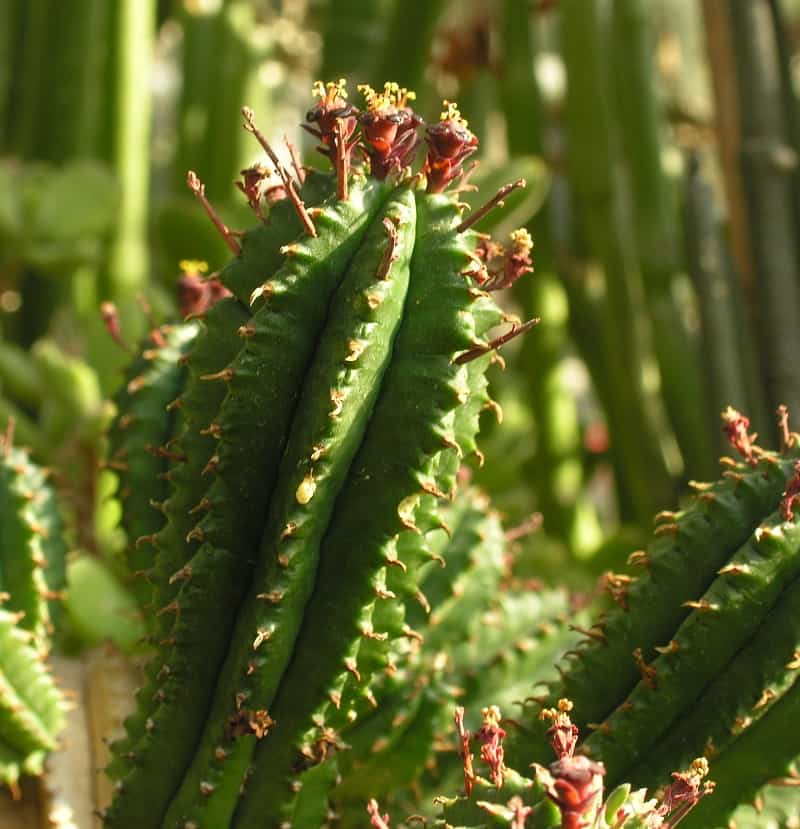The Euphorbia cereiformis shrub up to 1 meter high, its branches is erect, with up to fifteen ribs, reaching a width of up to 5 cm, green and dark green.
The ribs are narrow, with small tubers, the edges of the ribs have small serrated notches.
The thorns are simple, gray, up to 2 cm in length.
The flakes are small, approximately 3 mm, dry quickly, but can remain on the plant for several years
Similar to the cereus cactus, from which it got its name.
Euphorbia cereiformis is very fond of light, but like all succulents, it must be in the shade of direct sunlight, otherwise a sunburn of tender branches is inevitable.
Although the burn heals over time, leaving its mark on milkweed branches forever spoils the aesthetic appearance of the plant.
Euphorbia cereus responds to regular spraying.
Tips to take care of the Euphorbia cereiformis “Milk Barrel Cactus”
Illumination
Such a plant throughout the year needs very intense light and direct sunlight.
The most suitable windows are the south-west, south and southeast orientation. If the lighting is poor, then the euphoria will grow, the new growth will be very painful, and in some cases this will lead to the death of the entire plant.
To avoid this, you should use phytolamps for lighting, while remembering that the duration of the light throughout the year should be approximately 10 hours.
Temperature
In summer, the plant feels better at a temperature of 20 to 25 degrees.
All species with flowers have a mandatory period of inactivity, which is observed in the winter and requires a fresh content.
And all because the floral button marker starts at a temperature of 14 degrees.
Such succulent is quite resistant to sudden changes in temperature, but it should be remembered that it does not tolerate drafts. In this regard, you must be extremely cautious when airing the room.
How to water
There is a rule: the smaller the cactus-like plant is, the more often it needs to be watered.
You should also observe the condition of the soil. Abundant watering is carried out only after the soil dries deeply by ¼ part.
We cannot allow water to stagnate in the substrate, nor does it become sour.
This is especially true for those milkweeds that have a thick and fleshy stem that can rot very quickly.
But do not forget that some species react extremely negatively to the drying of a coma, for example, euphorbia to milk. They can respond by dropping the foliage.
In winter, when it is kept cool, you need to water much less, because in this period there is an even greater risk of rot in the root system and the root neck. +
Low humidity of urban apartments is quite adequate.
Earth mix
Adequate soil must be loose, neutral and have good air flow.
To plant, you can buy a dredge already prepared for cactus or do it yourself.
To do this, combine leaves, grass and peat soil, brick chips and thick river sand, which should be taken in equal proportions.
At the bottom of the pot, do not forget to make a good layer of expanded clay drainage.
Such a plant generally grows in poor soils, therefore, it should not be fertilized too often.
This procedure is carried out once a week.
To do this, use cactus fertilizer and take the dose indicated on the package.
If there is a period of inactivity in winter, then it is not necessary to apply fertilizer to the soil.
Transplant Characteristics
Euphorbia is transplanted only when its root system stops fitting in the pot.
It is not necessary to pinch and prune the succulents in the form of cacti, as well as euphorbia with white veined veins.
Species that branch strongly by nature (for example, milk Euphorbia) need to pinch the top of the stems.
This helps to give splendor to the crown and also helps prevent the strong growth of the bush.
Breeding methods
Euphorbia – “cactus” in the home, as a rule, propagated by children.
At the same time, leafy species can be propagated by cutting and seeds.
Before planting a cut stem on a substrate, it should be washed with milky juice and then left outdoors to dry.
To grow roots faster, the tip of the cut is recommended to treat the root.
Prepared cuttings should be planted in wet sand or a peat substrate.
For rooting, you need a light mini-teplichka, in which you need to maintain a certain level of humidity. Systematic ventilation is required.
Plagues and diseases
They are particularly resistant to diseases and pests. But they can get sick due to inadequate care.
The yellowish color of a large number of leaves throughout the crown in the summer is an air current or stagnation of water in the soil.
Yellowing is not a lot of lower leaves in the summer, a fairly natural process.
In the fall, the yellowing of a large amount of foliage is a species of deciduous in the species of deciduous, a natural process of preparation for the winter period.
Large brownish spots on the surface of the outbreak: burns left by sunlight.
There are many brown spots on the stem and they have different sizes, this rots due to the stagnation of water in the soil.
